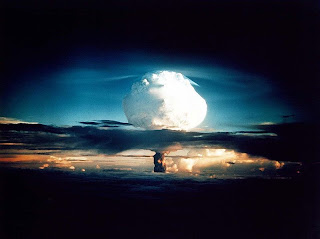In nuclear physics, nuclear fusion is a nuclear reaction in
which two or more atomic nuclei collide at very high speed and join
to form a new type of atomic nucleus (e.g. The energy that the Sun emits
into space is produced by nuclear reactions that happen in its core due to
the collision of hydrogen nuclei and the formation of helium nuclei). During this process,
matter is not conserved because some of the mass of the fusing nuclei is
converted to photons (energy). Fusion is the process that powers active
or "main sequence" stars.
The fusion of two nuclei with lower masses than iron (which, along with nickel,
has the largest binding energy per nucleon) generally releases energy,
while the fusion of nuclei heavier than iron absorbs energy.
The opposite is true for the reverse process, nuclear fission.
This means that fusion generally occurs for lighter elements only, and likewise,
that fission normally occurs only for heavier elements. There are extreme astrophysical
events that can lead to short periods of fusion with heavier nuclei.
This is the process that gives rise to nucleosynthesis, the creation of the
heavy elements during events such as supernovae.
Following the discovery of quantum tunneling by Friedrich Hund, in 1929 Robert Atkinson
and Fritz Houtermans used the measured masses of light elements to predict that
large amounts of energy could be released by fusing small nuclei. Building upon
the nuclear transmutation experiments by Ernest Rutherford, carried out several
years earlier, the laboratory fusion of hydrogen isotopes was first accomplished
by Mark Oliphant in 1932. During the remainder of that decade the steps of the
main cycle of nuclear fusion in stars were worked out by Hans Bethe. Research
into fusion for military purposes began in the early 1940s as part of the Manhattan
Project, but this was not accomplished until 1951 (see the Greenhouse Item nuclear test)
and nuclear fusion on a large scale in an explosion was first carried out on November 1,
1952, in the Ivy Mike hydrogen bomb test.
Research into developing controlled thermonuclear fusion for civil purposes
also began in earnest in the 1950s, and it continues to this day. Two projects, the National
Ignition Facility and ITER, are expected to have high gains, that is, producing
more energy than required to ignite the reaction, after 60 years of design improvements
developed from previous experiments.[citation needed] While these
ICF and Tokamak designs became popular in recent times, experiments
with Stellarators are gaining international scientific attention again,
like Wendelstein 7-X in Greifswald, Germany.


No comments:
Post a Comment